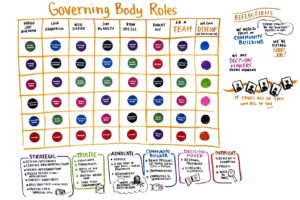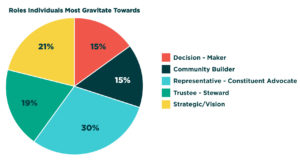


Authors:
Julia Novak, Executive Vice President – Raftelis (Email); Tanisha Briley, ICMA-CM, City Manager, Gaithersburg, Maryland; Dr. John Nalbandian, PhD, Professor Emeritus – University of Kansas
Management is a supporting and essential role in local governance and for local government managers there is no exception. Management supports the organization, the community, and, of course, supports the governing body. There is a dance that managers must do with their elected officials as they navigate the curved and blurry line between politics and administration, but this symbiotic relationship is built on the foundational premise that management is a supporting role.
Just as a manager’s role changes with each situation they encounter, the role an elected official plays also shifts and changes. In 2016, Julia Novak and Dr. John Nalbandian began working to define the various roles that local elected officials must play and to identify how those roles relate to effective governance. Since that time, they have worked with dozens of elected bodies to understand these roles, the activities associated with each role, and how elected officials envision they can enhance their own effectiveness.
These insights can be valuable to managers as they fine tune the “support role” and understand what can be done to support each role and help their elected body govern effectively together.
The six council governance roles identified by Novak and Nalbandian are Strategic/Vision – Big Picture Thinker; Community Builder – Bringing People Together; Oversight; Trustee – Steward; Decision-Maker; and Representative – Constituent Advocate.

Since their development in 2016, conversations about the six governance roles have been incorporated into retreats with governing bodies across the country. During these retreats, the groups discuss the activities associated with each of the roles and then individuals are asked to rank for themselves the roles that come most naturally to them. The percentage of respondents ranking each of the corresponding roles as where they gravitate towards the most is shown in the figure below. It is interesting to note that NONE the over 200 elected officials we have worked with identified Oversight as the role that they naturally gravitate towards and yet this is the role that creates distance/tension between staff and the governing body.
Once we understand how each individual ranks and identifies with the six roles, we are able to provide an aggregate ranking or group profile. The collective distribution of which roles governing bodies naturally gravitate towards is:

Then they are asked to discuss what roles they should focus more on to enhance effectiveness. The collective distribution of which roles governing bodies should focus on to be (even) more effective is:
The challenge for managers is to support the governing body in each of the roles to enhance effectiveness. The side-by-side table below allows us to see the juxtaposition of a few key elements of this ranking. Generally speaking, Representative – Constituent Advocate is the number 1 role that elected officials naturally gravitate towards and Community Builder is number 5. When asked where to focus to enhance effectiveness, Community Builder jumps to number 2, and Representative – Constituent Advocate moves to number 4. Finally, the Oversight role is the lowest rated role in both scenarios.
Roles | Associated Activities |
Strategic Vision | Strategic Vision |
Representative – | Community Builder |
Trustee – Steward | Trustee – Steward |
Decision-Maker | Representative – Constituent Advocate |
Community Builder | Decision-Maker |
Oversight | Oversight |
A quick summary of activities associated with each role is shown below.
Roles | Associated Activities |
Strategic Vision | - Strategic Planning |
Representative – | - Answering calls and emails from residents |
Trustee – Steward | - Looking at the long-term implications of decisions |
Decision-Maker | - Reading briefing materials |
Community Builder | - PrioritizationBeing present and listening to individuals and community groups |
Oversight | - Conduct the manager’s performance evaluation |
The reality for our elected officials is that there are times when these roles are in opposition to one another. Residents may be asking the Council to vote a particular way on an issue because of how that decision impacts them in the moment, but the “Trustee” will consider long term implications and perhaps make a different decision. When discussing this tension with Nalbandian at a Council Retreat, one Councilmember described this as a mindset they take on when considering important decisions: “If I think of our residents, the voters, my neighbors as my customers—then I am their customer service; but when I think of them as owners, then I am their trustee.” The Trustee is duty bound to make decisions in the best interest of the community, even despite “customer” opposition to do so.
The Community Building role deserves special attention since there is noticeable separation from actual and desired ranking. As elected officials think about moving the needle on their own performance as a governing body, they see the Community Building role as a potential pathway. Parks, gathering areas, community centers, and town squares are physical spaces we can build and maintain that allow people to gather and be connected to their neighbors. Programming those areas with special events and celebrations encourages people to engage directly with the local government and the community. Convening conversations about important community issues are also an opportunity to reinforce that the local government cares about the events and issues facing the community and wants to hear from residents. The balance, of course, is to create an environment for true civil discourse. Many of our traditional methods of getting public input, such as public hearings where people get three minutes to state their opinion, are not consistent with community building—or even real engagement. Community Building is deeper. According to Nalbandian, “win-lose politics have no place if community building is the goal.”
Given the divergence between the actual role a governing body gravitates towards and their desired role, the question is, how do we do this? What can the manager and staff do in this supporting role to help the governing body achieve the best for their community?
Our practical experience as consultants and managers suggests the following:
In Gaithersburg, Maryland, there is a long tradition of strategic planning, financial stewardship, civility, and community engagement. When Tanisha Briley became their City Manager, her job was to build on this foundation and “level up” organizational performance. “The challenge was to take an already high performing governing body and integrate new elected officials into the best part of the governance culture,” she said. “We did that by intentionally talking about the importance of working well together to achieve results and refreshing the strategic plan so the Council was connected and committed to the long-term goals of the City.”
As was stated in the beginning, management is a supporting role and while their primary focus is the complexity of service delivery issues, fulfilling that role means supporting the governing body in each of theirs. It must be intentional and the manager must be in tune with the priorities of the elected officials and be effective in translating those into administrative/service delivery decisions. We have facilitated governance conversations with dozens of governing bodies and hundreds of individual elected officials. Only two governing bodies felt it was most important to focus on their Oversight role to improve effectiveness and, in both those situations, the manager moved on within the year. Accountability is an important part of being a local government professional and builds trust between the governing body and the administration. However, it is equally important to support the governing body in achieving their objectives. This ensures alignment between “politics and administration” and creates a collaborative mentality which can foster aspirational goals for the community.